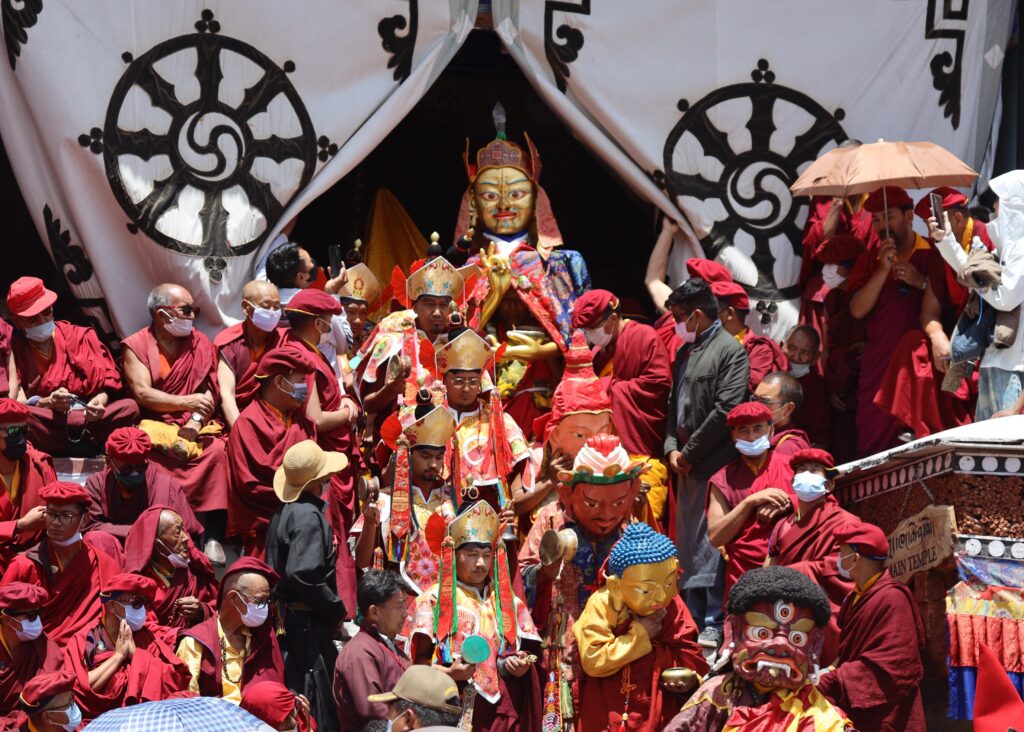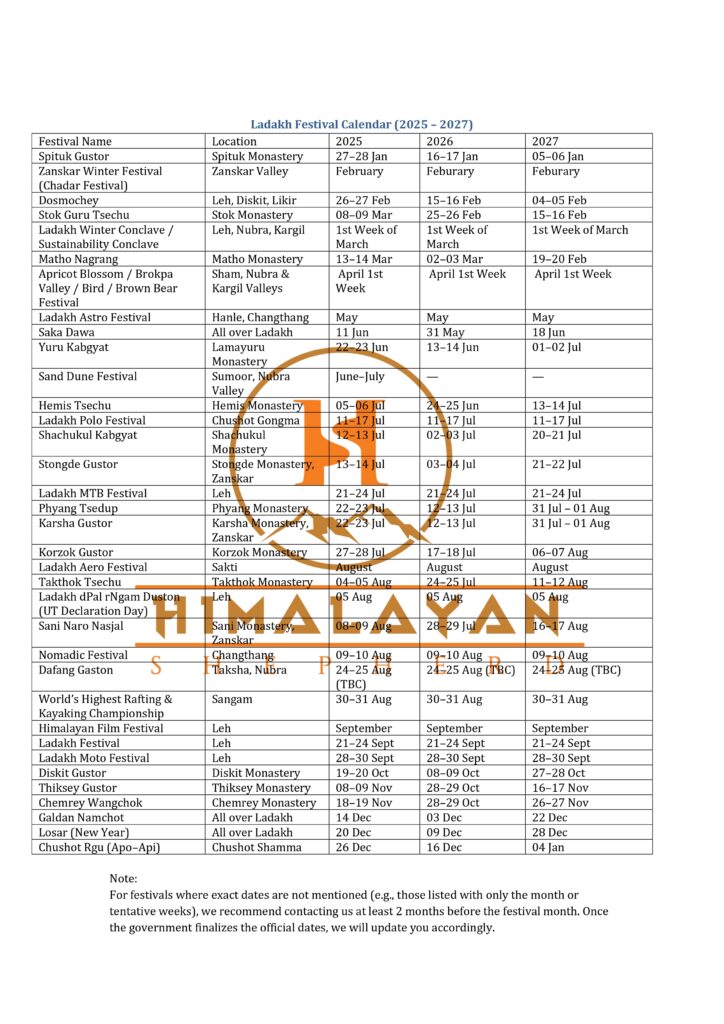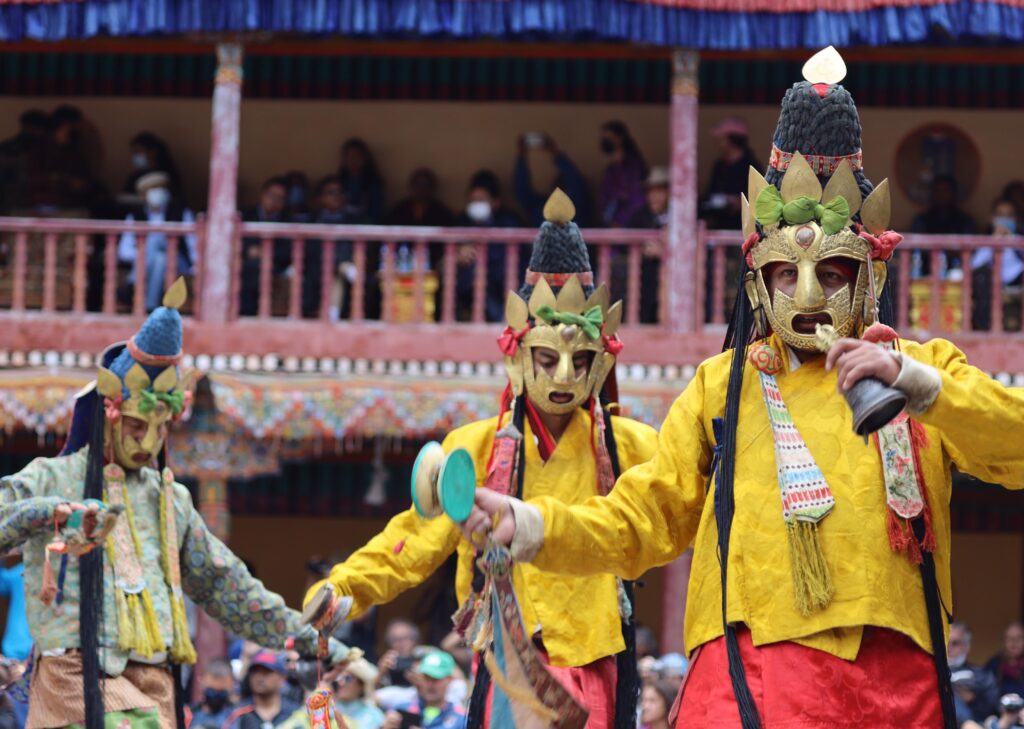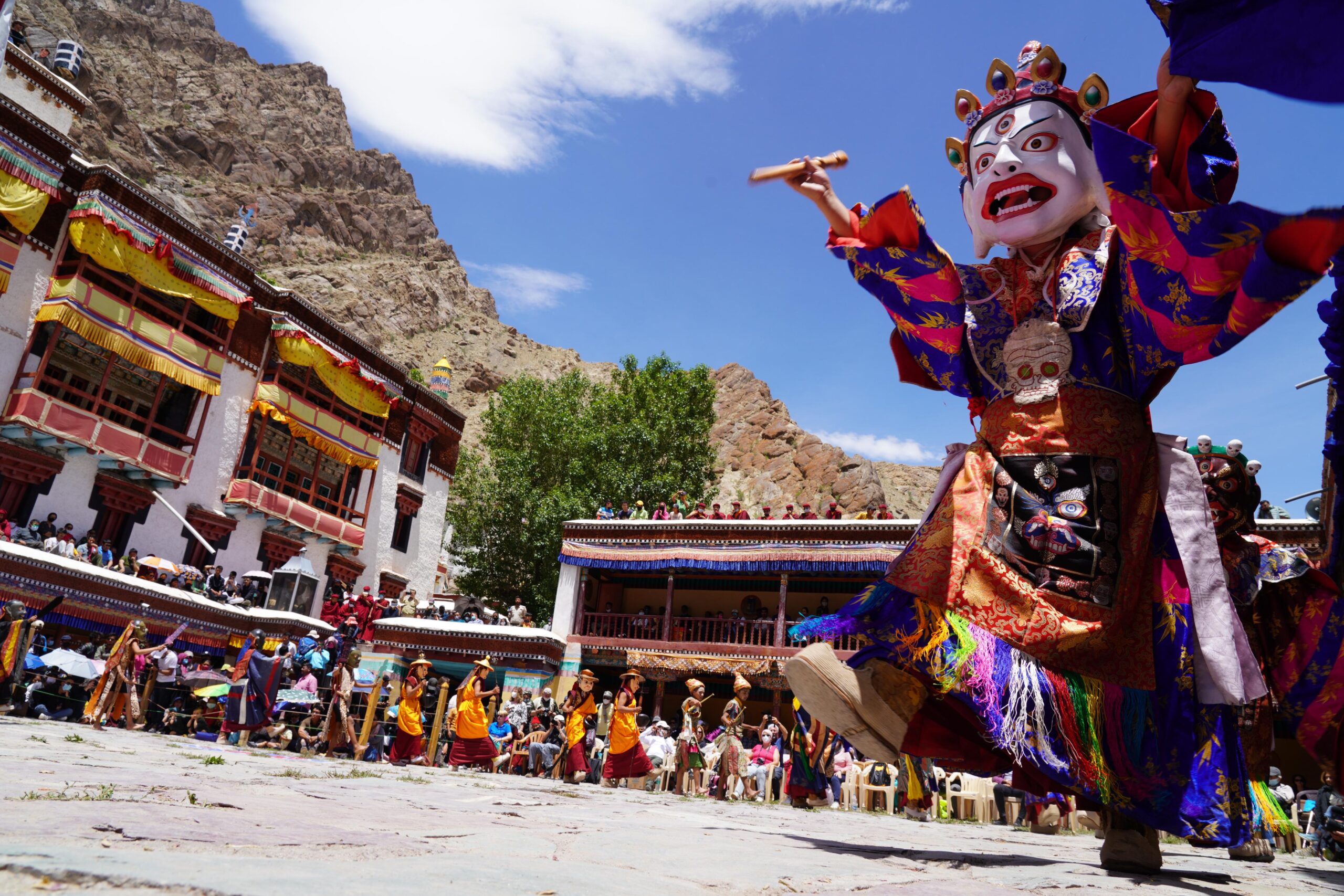High in the mystical Himalayas, where rugged mountains kiss the skies and silence echoes through vast valleys, Ladakh comes alive with a kaleidoscope of color, music, and ancient rituals during its vibrant festivals. More than just jovial occasions, the festivals of Ladakh offer a profound glimpse into the region’s deep-rooted Buddhist heritage and resilient mountain culture. From the vibrant masked dances at Hemis to the quiet spiritual serenity of Losar, every jubilee weaves a tale steeped in ancient tradition and wrapped in mysticism. Experience the vibrant rituals and spiritual energy of the region through its colorful celebrations, with many tour packages in Ladakh offering exclusive access to these unforgettable festivals.

Join us as we take a deep drive through the key festivals of this Himalayan wonderland, each steeped in spirituality, culture, or seasonal celebration—described in order of the calendar:
- Spituk Gustor: Held across two days in January at the Spituk Monastery, this ritualistic early winter festival marks the end of the Tibetan year with the public display of a giant thangka of Je Tsongkhapa being the highlight. At the centre of this festival are the cham dances that end with the deeply symbolic burning of sacrificial tormas (dough idols). This act is believed to cleanse negativity and usher in peace and prosperity for the New Year. To witness the spiritual grandeur of Spituk Gustor—where masked dances and sacred rituals unfold against the backdrop of ancient monasteries—consider booking with the best travel agency in Leh Ladakh for a seamless and immersive cultural experience.
2. Dosmochey: Started by the royal families of Ladakh, this two day annual festival in February marks the onset of warmer days and the end of the chilly winter. The monks use thread crosses that are believed to trap evil spirits and protect the place against natural disasters. It involves monks performing sacred rituals, burning effigies of evil and donning masks to exorcise malevolent forces. The main highlights include colorful decorations of the Leh Palace, the captivating sounds of the drums and unique cham dances.
3. Stok Guru Tsechu: Stok Guru Tsechu is a distinctive Ladakhi festival celebrated with vibrant mask dances and age-old rituals in the Stok Monastery. Central to the event are two laymen oracles who, after weeks of meditation and intense spiritual preparation, deliver predictions believed to guide the community. This blend of ceremony and prophecy reflects the deep-rooted Buddhist spiritual practices unique to the region.
Location: Stok Monastery
4. Matho Nagrang: Every spring, the quiet halls of Matho Monastery burst to life with swirling robes, sacred chants, and the mesmerizing energy of the Nagrang Festival. After completing a whole month of deep meditation, two oracles along with masked dancers predict prophecies while the villagers gather in awe. Don’t forget to book a taxi service in Leh Ladakh to experience the festival of black oracles.
5. Saka Dawa: Saka Dawa is one of Ladakh’s most sacred days, honoring the birth, enlightenment, and passing of Lord Buddha in a single observance. People from all over Ladakh participate in a procession called Bhumskor where they carry sacred articles depicting the life and noble acts of Buddha. Monasteries fill with chants and butter lamps, as locals embrace acts of compassion, prayer, and spiritual reflection.
6. Yuru Kabgyat: This captivating spiritual festival takes place at the iconic Lamayuru Monastery in late June or early July, where monks gather to perform masked dances believed to restore cosmic harmony and safeguard the valley. To immerse yourself in the vibrant Yuru Kabgyat festival filled with the electric sounds of drums and chants, trust the best travel agency in Leh Ladakh to craft a culturally rich and personalized itinerary.
7. Hemis Tsechu: Hemis Tsechu is Ladakh’s grandest festival, celebrated with mesmerizing cham dances that honor the legendary Guru Padmasambhava, the founder of Tantric Buddhism. The Hemis monastery courtyard comes alive with color, music, and stories passed down through generations. It’s a powerful blend of devotion and performance that leaves visitors both awed and spiritually uplifted.

8. Ladakh Polo Festival: Experience a captivating amalgamation of sport and culture overlooking the mighty Himalayas by booking the best tour packages in Ladakh. The Ladakh Polo festival takes place at Chushot Gongma from 11th to 17th July. It packs an unforgettable adventure combining the ancient equestrian rituals of Ladakh with the modern sport of polo.
9. Shachukul Kabgyat: This is an incredibly powerful and culturally significant festival for the close-knit community of the Durbuk region of Ladakh in the month of July. Monks of the Shachukul Monastery dress up in colorful attires to represent different deities and perform masked dances that signify the triumph of good over evil. The celebrations conclude with the cutting of Torma (ritual cake) during the final rites.
10. Stongde Gustor: Stongde Gustor takes place in the stunning Zanskar Valley, bringing the Stongde Monastery to life with sacred rituals and delightful Cham dances. This July festival reenacts age-old tales of virtue overcoming darkness through symbolic performances. For a smooth and scenic journey to the Stongde Gustor Festival in Zanskar, opt for a reliable taxi service in Leh Ladakh that ensures convenience amidst the region’s rugged terrain.
11. Phyang Tsedup: Phyang Tsedup is an enchanting festival held at the ancient Phyang Monastery dedicated to the saint Skyoba Jigten Gombo, founder of the Drikung Kagyu lineage. Monks don bright brocade robes that bring Buddhist deities to life through traditional masked dances. The surroundings come alive with the sounds of traditional instruments, drawing both locals and visitors into the spiritual celebration.
12. Karsha Gustor: Karsha Gustor is a significant spiritual festival held at Zanskar’s largest Karsha monastery, offering a profound glimpse into the Gelugpa order’s monastic traditions. Monks perform a dynamic Black Hat dance that symbolizes the purging of evil and the victory of good. It concludes with the destruction of the sacrificial cake called torma that represents evil. Immerse yourself in this festival set against a backdrop of snow-capped mountains using our best tour packages in Ladakh.
13. Korzok Gustor: The only thing that can amplify the beauty of the pristine views of the Tso Moriri Lake is the Korzok Gustor festival set against it. The highlight of this two-day festival is the gathering of the Changpa nomadic groups dressed in colourful traditional attire at the Korzok Monastery, giving a glimpse into the unique culture of Ladakh’s remote highlands.
14. Takthok Tsechu: This festival marks the celebration of Guru Rinpoche’s Life and honours his teachings. The Takthok Monastery was used by Guru Rinpoche for meditation in the eighth century and is believed to have a profound connection to Buddhist traditions. It houses ancient rock chambers where the masked dances and art forms portraying the life of Guru Rinpoche take place.

15. Sani Naro Nasjal: The Sani Naro‑Nasjal festival is a highly anticipated community event that combines religious devotion with cultural tradition. Masked dancers from the nearby Bardan Monastery perform ritual cham dances, while villagers take part in prayers and ceremonies to celebrate their spiritual heritage. The festival includes the unveiling of the Naropa statue, which offers pilgrims the opportunity to receive blessings. A touching aspect of the event is the welcoming of newlywed couples through the exchange of ceremonial khataks.
16. Ladakh Festival: It was launched as a showcase of Ladakh’s vibrant culture and to boost tourism in the off-season from 21st to 24th September in Leh. This festival draws visitors from around the world with colorful folk dances, pulsating music, thrilling archery competitions, and a lively handicraft and food market. Experiencing all this is even more seamless when you arrange sightseeing through a trusted taxi service in Leh Ladakh, letting you dive deep into Ladakhi life with ease.
17. Diskit Gustor: Diskit Gustor is one of the major festivals in the Nubra valley of Ladakh, with a gathering of over 5.5 Lakh devotees including both locals and travellers at the Diskit Monastery. Longhorns and cymbals hum through the valley complete with songs and cham dances by the monks in the month of October. The festival concludes with the burning of effigies, symbolising the triumph of good over evil. Witness the mystical charm of the Diskit Gustor Festival with curated itineraries from the best travel agency in Leh Ladakh.
18. Thiksey Gustor: This two-day celebration at the Thiksey Monastery marks one of the final festivals in Ladakh leading up to the Losar festivities. It commences with early morning prayers by monks followed by cham dances. The highlight of the festival is the Black Hat dance performed by monks who end it with a sacrificial cake cutting to signal the triumph of good over evil. The beat of cymbals, drums and longhorns attract both locals and visitors alike.
19. Chemrey Wangchok: Though modest in scale, the Chemrey Wangchok festival holds great cultural importance and is deeply connected to the daily practices of monastic life. Monks from the Drukpa tradition in Chemrey Monastery engage in a week of intense meditation before performing ritual cham dances throughout the two-day event.
20. Galdan Namchot: Galdan Namchot celebrates the birth of Je Tsongkhapa, the revered founder of the Gelugpa tradition of Tibetan Buddhism. This December festival also signals the start of New Year festivities in Ladakh. Throughout the region, homes and monasteries glow warmly with butter lamps, symbolizing the triumph of light over darkness, while families come together to prepare and enjoy traditional Ladakhi dishes in joyous harmony.
21. Losar (New Year): Losar, the most eagerly awaited festival in Ladakh, bursts to life with vibrant celebrations and deep-rooted traditions. Locals come together to perform age-old rituals, including theatrical stage fights, the captivating Ibex deer dance, and dramatic enactments of the king and his court. Experiencing Losar is a highlight in most tour packages in Leh Ladakh, offering visitors an authentic glimpse into the region’s rich cultural tapestry.
22. Chushot Rgu (Apo-Api): Chushot Rgu, also known as the Apo-Api Festival, is a unique village celebration observed in Chushot village near Leh. Rooted in ancestral worship, the festival honors the spirits of forefathers—Apo (grandfather) and Api (grandmother)—through traditional rituals, storytelling, and communal gatherings. Families come together to prepare local delicacies, offer prayers, and share meals, strengthening community bonds and cultural identity.
Ladakh’s festivals are more than cultural events—they are vivid expressions of tradition, faith, and community set against the backdrop of towering mountains and timeless monasteries. From vibrant Cham dances to intimate village gatherings, each celebration tells a story woven into the fabric of Ladakhi life. With a reliable taxi service in Leh Ladakh, exploring these unique festivals becomes not just convenient, but an unforgettable journey into the heart of the Himalayas.

Leave a Reply